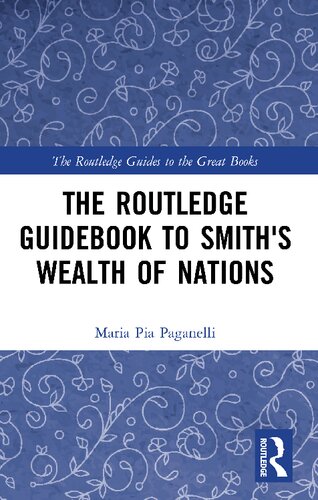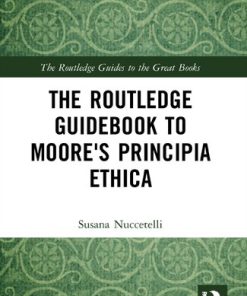The Routledge Guidebook to Smith’s Wealth of Nations 1st Edition by Maria Pia Paganelli 1000733866 9781000733860
$50.00 Original price was: $50.00.$25.00Current price is: $25.00.
The Routledge Guidebook to Smith s Wealth of Nations 1st Edition by Maria Pia Paganelli – Ebook PDF Instant Download/Delivery: 1000733866, 9781000733860
Full dowload The Routledge Guidebook to Smith s Wealth of Nations 1st Edition after payment

Product details:
ISBN 10: 1000733866
ISBN 13: 9781000733860
Author: Maria Pia Paganelli
Adam Smith (1723–1790) is famous around the world as the founding father of economics, and his ideas are regularly quoted and invoked by politicians, business leaders, economists, and philosophers. However, considering his fame, few people have actually read the whole of his magnum opus The Wealth of Nations – the first book to describe and lay out many of the concepts that are crucial to modern economic thinking. The Routledge Guidebook to Smith’s Wealth of Nations provides an accessible, clear, and concise introduction to the arguments of this most notorious and influential of economic texts. The Guidebook examines: the historical context of Smith’s though and the background to this seminal work the key arguments and ideas developed throughout The Wealth of Nations the enduring legacy of Smith’s work The Routledge Guidebook to Smith’s Wealth of Nations is essential reading for students of philosophy, economics, politics, and sociology who are approaching Smith’s work for the first time.
The Routledge Guidebook to Smith s Wealth of Nations 1st Table of contents:
1 Adam Smith and the Scotland of his days
The Scottish economy
Scottish politics
The Highlands and the stages of development
Improvements and enlightenment
Further readings
2 Introduction and Book I, Chapters I–III
Introduction
Book I, Chapter I: of the division of labor
Book I, Chapter II: of the principle that gives occasion to the division of labor
Book I, Chapter III: that the division of labor is limited by the extent of the market
Note
Further readings
3 Book I, Chapters IV–VII
Book I, Chapter IV: of the origin and use of money
Book I, Chapter V: real and nominal price of commodities or of their price in labor and their price in money
Book I, Chapter VI: of the component parts of the price of commodities
Book I, Chapter VII: natural and market price of commodities
Note
Further readings
4 Book I, Chapters VII–X
Book I, Chapter VIII: of the wages of labor
Book, I Chapter IX: of profits of stock
Book I, Chapter X: of wages and profits in different employments of labor
Part I: inequalities arising from the nature of the employment
Part II: inequalities occasioned by the policy of Europe
Further readings
5 Book I, Chapter XI
Book I, Chapter XI: of the rent of land
Part I: of the produce of land that always affords rent
Part II: of the produce of land that sometimes does and sometimes does not afford rent
Part III: of the variation in the proportion between the respective values of that sort of produce that always affords rent, and that which sometimes does and sometimes does not afford rent
Digression concerning the variations in the value of silver during the course of the four last centuries
First period
Second period
Third period
Variation in the proportion of the value of gold and silver and grounds of suspicions on the decrease in the value of silver good
Different effects of progress of improvement on the real price of three rude produce
First sort
Second sort
Third sort
Conclusion of the digression concerning the variation in the value of silver
Effects of the progress of improvement upon the real price of manufacture
Conclusion
Further readings
6 Book II
Book II: of the nature, accumulation, and employment of stock
Book II, Chapter I: of the division of stock
Book II, Chapter II: of money considered a particular branch of the general stock of society
Book II, Chapter III: of the accumulation of capital or of productive and unproductive labor
Book II, Chapter IV: of stock lent at interest
Book 2, Chapter V: of different employment of capital
Further readings
7 Book III
Book III: of different progress of opulence in different nations
Book III, Chapter I: of the natural progress of opulence
Book III, Chapter II: of the discouragement of agriculture in the ancient states of Europe after the fall of the Roman Empire
Book III, Chapter III: of the rise and progress of cities and towns after the fall of the Roman Empire
Book III, Chapter IV: how the commerce of the towns contributed to the improvement of the country
Further readings
8 Book IV, Chapters I–VI
Book IV: of the systems of political economy
Introduction
Book IV, Chapter I: of the principle of commercial or mercantile system
Book IV, Chapter II: of restraints upon the importation from foreign countries of such goods that can be produced at home
Book IV, Chapter III: of the extraordinary restraints upon importation of goods of almost all kinds from countries with which the balance of trade is supposed to be disadvantageous
Part I: of the unreasonableness of those restraints even upon the principles of the commercial system
Digression concerning banks of deposit, particularly concerning that of Amsterdam
Part II: of the unreasonableness of those extraordinary restraints upon other principles
Book IV, Chapter IV: of drawbacks
Book IV, Chapter V: of bounties
Digression concerning the corn trade and corn laws
Book IV, Chapter VI: of treaties of commerce
Further readings
9 Book IV, Chapters VII–IX
Book IV, Chapter VII: of colonies
Part First: of the motives for establishing new colonies
Part Second: causes of the prosperity of the new colonies
Part Third: of the advantages which Europe has derived from the discovery of America and from the passage to the East Indies by the Cape of Good Hope
Book IV, Chapter VIII: conclusion of the mercantile system
Book IV, Chapter IX: of the agricultural systems, or of those systems of political oeconomy, which represent the produce of land as either the sole or the principal source of the revenue and wealth of every country
Further readings
10 Book V, Chapter I
Book V, Chapter I: of the expenses of the sovereign or commonwealth
Part First: of the expense of defense
Part II: of the expense of justice
Part III: of the expence of public works and public institutions
Article I: of public works and institutions for facilitating the commerce of the society
Article II: of the expence of the instruction for the education of the youth
Article III: of the expence of the institutions for the instruction of people of all ages
Part Fourth: of the expence of supporting the dignity of the sovereign
Conclusion of the chapter
Further readings
11 Book V, Chapters II–III
Book V, Chapter II: of the sources of the general or public revenue of the society
Part I: of the funds or sources of revenue which may peculiarly belong to the sovereign or commonwealth
Part II: of taxes
Article I: taxes upon rent; taxes upon the rent of the land
Taxes which are proportioned, not to the rent, but to the produce of the land
Taxes upon rent of houses
Article II: taxes upon profits; or upon the revenue arising from stock
Taxes upon the profit of a particular employment
Appendix to articles I and II: taxes upon the capital value of lands, houses, and stock
Article III: taxes upon wages of labor
Article IV: taxes which, it is intended, should fall indifferently upon every different species of revenue
Capitation taxes
Taxes upon consumable commodities
Book V, Chapter III: of public debts
Further readings
12 Legacy
Further readings
Index
People also search for The Routledge Guidebook to Smith s Wealth of Nations 1st:
wealth of nations study guide
the routledge handbook of the economics of education
the routledge international handbook on max weber
the routledge handbook of the stoic tradition
Tags:
Maria Pia Paganelli,Routledge Guidebook,Wealth of Nations
You may also like…
Uncategorized
An Inquiry into the Nature and Causes of the Wealth of Nations 1776 1st Edition Adam Smith
Uncategorized
An Inquiry into the Nature and Causes of the Wealth of Nations 1776 1st Edition Adam Smith
Politics & Philosophy - Social Sciences
Uncategorized
Politics & Philosophy - Government & Politics
Adam Smith and the Wealth of Nations The Discovery of Capitalism and Its Limits Diatkine
Politics & Philosophy - Anthropology
Uncategorized
An Inquiry into the Nature and Causes of the Wealth of Nations 1776 1st Edition Adam Smith
Education Studies & Teaching - Philosophy of Education
The Routledge Guidebook to Moore s Principia Ethica 1st Edition Susana Nuccetelli
Uncategorized







